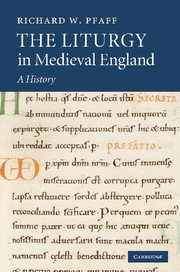Book contents
- Frontmatter
- Contents
- Preface
- Sigla and editorial conventions
- Bibliographical abbreviations
- Nicknames for manuscripts frequently referred to
- 1 Introduction
- Excursus: on sources
- 2 Early Anglo-Saxon England: a partly traceable story
- Excursus: on the terms Gregorian and Gelasian as used here
- 3 Later Anglo-Saxon: liturgy for England
- 4 The Norman Conquest: cross fertilizations
- Excursus: on method in the comparison of liturgical texts
- 5 Monastic liturgy, 1100–1215
- Excursus: on ascription of liturgical books to specific churches
- 6 Benedictine liturgy after 1215
- 7 Other monastic orders
- 8 The non-monastic religious orders: canons regular
- 9 The non-monastic religious orders: friars
- Excursus: on liturgical books from female religious houses
- 10 Old Sarum: the beginnings of Sarum Use
- 11 New Sarum and the spread of Sarum Use
- 12 Exeter: the fullness of secular liturgy
- 13 Southern England: final Sarum Use
- 14 Regional Uses and local variety
- 15 Towards the end of the story
- Index of Manuscripts
- Index of Saints
- General Index
4 - The Norman Conquest: cross fertilizations
Published online by Cambridge University Press: 20 March 2010
- Frontmatter
- Contents
- Preface
- Sigla and editorial conventions
- Bibliographical abbreviations
- Nicknames for manuscripts frequently referred to
- 1 Introduction
- Excursus: on sources
- 2 Early Anglo-Saxon England: a partly traceable story
- Excursus: on the terms Gregorian and Gelasian as used here
- 3 Later Anglo-Saxon: liturgy for England
- 4 The Norman Conquest: cross fertilizations
- Excursus: on method in the comparison of liturgical texts
- 5 Monastic liturgy, 1100–1215
- Excursus: on ascription of liturgical books to specific churches
- 6 Benedictine liturgy after 1215
- 7 Other monastic orders
- 8 The non-monastic religious orders: canons regular
- 9 The non-monastic religious orders: friars
- Excursus: on liturgical books from female religious houses
- 10 Old Sarum: the beginnings of Sarum Use
- 11 New Sarum and the spread of Sarum Use
- 12 Exeter: the fullness of secular liturgy
- 13 Southern England: final Sarum Use
- 14 Regional Uses and local variety
- 15 Towards the end of the story
- Index of Manuscripts
- Index of Saints
- General Index
Summary
It would be unreasonable to suppose that what is conventionally known as the Norman Conquest, beginning (just barely) with William I's victory at Hastings on 14 October 1066, made an immediate and decisive difference in the practice of the liturgy throughout England. It would be equally unreasonable to maintain that by, say, the deaths of William II in August of 1100 or of Anselm in April of 1109 the overall picture of the liturgy in England showed no marked influence as a consequence of ecclesiastical developments connected with the new regime. The present chapter will attempt to sketch a picture characterized by something of a balance between the “English” aspects predominant in the previous chapter and marks of the new Norman presence. First, though, it may be useful to indicate the picture's dimensions.
In structural terms, the number of provinces and dioceses did not change from what it had been in 1065. York continued as an archbishopric, even though its province contained only itself and Durham (which became monastic in 1083). Canterbury continued to have twelve suffragan sees, but there were six changes in location: Dorchester to Lincoln in 1072, Selsey to Chichester in 1075, Lichfield to Chester in 1075 (eventually to Coventry, 1102), Sherborne (incorporating Ramsbury) to Salisbury (“Old Sarum”) in 1078, Wells to Bath in 1088, Elmham to Thetford in about 1091 and thence to Norwich in 1095. The English phenomenon of the monastic cathedral, unknown in Normandy, survived, and indeed grew stronger with the addition of Bath and Norwich, and also of Rochester (which became monastic around 1080) and eventually of both Coventry and the newly founded (1109) see of Ely.
- Type
- Chapter
- Information
- The Liturgy in Medieval EnglandA History, pp. 101 - 140Publisher: Cambridge University PressPrint publication year: 2009



